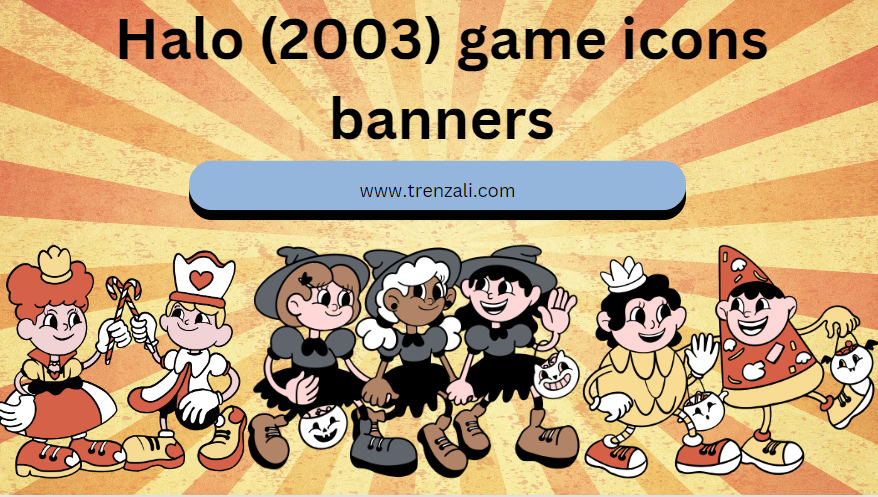Halo (2003) game icons banners established
The 2001 release of Combat Evolved marks a turning point in the history of first-person shooters. By 2003, Halo had established itself as an integral part of gaming culture, resulting in a wide range of merchandise and digital assets, such as game icons and banners. The “Halo (2003) game icons banners” are the subject of this article, which delves into their significance, development, influence on gaming culture, and current relevance.Halo’s Rise to Power: Halo: Combat Evolved: The Beginning of a Franchise In November 2001, Bungie and Microsoft Game Studios released Combat Evolved, Halo (2003) game icon banners developed by Bungie. It was praised for its revolutionary gameplay, compelling story, and multiplayer capabilities, which led to its rapid success as a best-seller. With a sequel and a plethora of related media and merchandise, Halo had established itself as a cultural phenomenon by 2003.The importance of visual branding Halo was not an exception when it came to visual branding. Due to the game’s popularity, various “Halo (2003) game icons banners” were produced, which fans and players utilized across multiple platforms. These digital assets weren’t just pretty things; They represented the community and identity of the game.The Development of Game Icons and Banners In comparison to current standards, the initial designs of game icons and banners in 2003 were relatively Halo (2003) game icon banners straightforward. The game’s logo, Master Chief’s helmet, or other well-known Halo symbols were typically featured on early Halo icons. Key artwork or screenshots from the game were frequently featured in banners to convey the game’s essence.Relevance to the Gaming Community For fans, “Halo (2003) game icons banners” were a means of expressing their devotion to the franchise. These Halo (2003) game icons banners advanced resources were utilized in discussions, web-based entertainment, and individual sites, permitting fans to show their Halo (2003) game icons banners enthusiasm and associate with others locally. The widespread use of these banners and icons contributed to the development of a sense of community within the Halo community.
Halo (2003) game icons banners Effect
The creation and far-reaching utilization of “Radiance (2003) game symbols flag” altogether affected computerized media. They set an example for how digital assets related to games could be used to promote and improve a game’s online presence. Numerous Halo (2003) game icons banners resulting games took on comparable procedures, perceiving the Halo (2003) game icon banners benefit of making outwardly engaging and effectively shareable computerized content.Creations and mods by fans Halo’s popularity also led to a rise in fan-made content. Fans began creating their banners and icons, enhancing the game’s digital ecosystem. This trend demonstrated how fans could contribute to the cultural spread of a game and the creative potential of the gaming community.
Also Read : Kaswire
Halo (2003) game icons banners Advanced Media
Relevance in the Present, Reminiscence, and Legacy In the present, the “Halo (2003) game icons banner” holds nostalgic significance for many gamers. They serve as a reminder of the gaming scene in the early 2000s and the influence Halo had on the industry. Fans who want to relive the glory days of Halo and celebrate its legacy frequently revisit Halo (2003) game icon sbanners these digital assets.Applications Today Even in today’s gaming environment, Halo’s digital branding principles are still applicable. Understanding the significance of visual identity in fostering a strong community and enhancing player engagement, game developers continue to produce icons and banners that capture the essence of their titles.Corona (2003) game symbols standard” alludes to the advanced symbols and flag Halo (2003) game icons banners m ade to advance and address Radiance: Combat developed around 2003. Fans used these assets on a variety of online platforms to show their enthusiasm and support for the game.
Halo (2003) game icons banners standards significant
Game symbols and pennants were critical for Corona as they laid out the game’s visual character Halo (2003) game icons banners and cultivated areas of strength for a local area among players. They made it possible for fans to demonstrate their devotion to the series and connect with others who shared their enthusiasm.
Game symbols flags impact the gaming business
The power of visual branding in the gaming industry was demonstrated by the success of Halo’s icons and banners. They set the standard for Halo (2003) game icons banners how digital assets could be used to promote games and interact with the community, which led many other games to follow suit.
Halo (2003) game icons banners today
Yes, the “Halo (2003) game icons banners” holds sentimental value for many fans and is frequently rediscovered as a means of commemorating the game’s history. Modern game branding and community engagement strategies continue to be influenced by the principles that led to their creation.
Locate authentic halo (2003) game icons banners
The original Halo (2003) game icons banner can frequently be found in Halo fan sites, archives, and fan communities. Some might also be available on official Halo channels or on special anniversary releases that pay tribute to the history of the franchise.The Halo (2003) game icons banners had a significant impact on the game’s visual identity: Combat evolved and developed a thriving player community. They had an unquestionable influence on gaming culture and established digital branding standards that are still relevant today. As we think back on the mid-2000s and the tradition of Radiance, these computerized resources stay a loved piece of gaming history, encapsulating the enthusiasm and imagination of the Halo (2003) game icons banners Corona people group.The 2001 release of Combat Evolved marks a turning point in the history of first-person shooters. By 2003, Radiance had solidly dug into itself in gaming society, prompting an assortment of related stock and computerized resources, including game symbols and flags. The “Halo (2003) game icons banners” are the subject of this article, which delves into their significance, development, influence on gaming culture, and current relevance.
Halo (2003) game icons banners Power Combat
The Beginning of a Franchise Battle Advanced, created by Bungie and distributed by Microsoft Game Studios, hit the market in November 2001. It immediately turned into a smash hit, lauded for its progressive Halo (2003) game icons banners ongoing interaction, convincing story, and multiplayer capacities. With a sequel and a plethora of related media and merchandise, Halo had established itself as a cultural phenomenon by 2003.The importance of visual branding Halo was not an exception when it came to visual branding. Due to the game’s popularity, various “Halo (2003) game icons banners” were produced, which fans and players utilized across Halo (2003) game icon banners multiple platforms. These digital assets weren’t just pretty things; They represented the community and identity of the game.
The Development of Game Icons
The Development of Game Icons and Banners In comparison to current standards, the initial designs of halo game icons and banners in 2003 were relatively straightforward. Early Radiance symbols regularly highlighted the game’s logo, Expert Boss’ head protector, or other conspicuous images from the game. Standards frequently displayed key workmanship or in-game screen captures, intended to catch the quintessence of the game.Relevance to the Gaming Community For fans, “Halo (2003) game icons banners” were a means of expressing their devotion to the franchise. These advanced resources were utilized at gatherings, web-based entertainment, and individual sites, permitting fans to show their energy and associate with others locally. The widespread use of these banners and icons contributed to the development of a sense of community within the Halo community.
The Effect on Gamers’ Culture Halo (2003) game icons banners
Influence on Digital Media The “Halo (2003) game icons banner” was created and used a lot. This had a big effect on digital media. They set a trend for how game-related computerized resources could be utilized to advance and improve a game’s presence on the web. Recognizing the importance of creating digital content that is both visually appealing and simple to share, numerous subsequent games adopted similar strategies.Creations and mods by fans Halo’s popularity also led to a rise in fan-made content. Lovers started to Halo (2003) game icons banners plan their symbols and flags, adding to the game’s computerized environment. This trend demonstrated how fans could contribute to the cultural spread of a game and the creative potential of the gaming community.Relevance in the Present, Reminiscence, and Legacy In the present, the “Halo (2003) game icons banner” holds nostalgic significance for many gamers. They serve as a reminder of the gaming scene in the early 2000s and the influence Halo had on the industry. These computerized resources are frequently returned by fans who need to remember the brilliant time of Corona and praise its inheritance.
Halo (2003) game icons banners symbols and standards
Applications Today Even in today’s gaming environment, Halo’s digital branding principles are still applicable. Game designers keep on making symbols and Halo (2003) game icons banners standards that catch the substance of their titles, grasping the significance of visual personality in cultivating major areas of strength for and improving player commitment.
banners for the Halo (2003) video game
“Radiance (2003) game symbols standard” alludes to the computerized symbols and pennants made to advance and address Corona: Combat Halo (2003) game icons bannersd eveloped around 2003. These resources were utilized by fans on different internet-based stages to show their help and excitement for the game.
Demonstrate of Halo’s game icons and banners
Halo’s game icons and banners were crucial because they helped players feel a strong sense of community and helped establish the game’s visual identity. They Halo (2003) game icon banners made it possible for fans to demonstrate their devotion to the series and connect with others who shared their enthusiasm.
Impact of the Halo (2003) game icons banners
The power of visual branding in the gaming industry was demonstrated by the success of Halo’s icons and banners. Halo (2003) game icon banners Relevant to use “Halo (2003) game icons banners” todayYes, the “Halo (2003) game icons banner” holds sentimental value for many fans and is frequently rediscovered as a means of commemorating the game’s history. The standards behind their creation keep on affecting current game marking and local area commitment methodologies.
Unique Radiance (2003) game symbols pennants
The original “Halo (2003) game icons banner” can frequently be found in Halo fan sites, archives, and fan communities. Some might also be available on official Halo channels or on special anniversary releases that pay tribute to the history of the franchise.
Halo (2003) game icons banners Visual identity
The “Halo (2003) game icons banners” had a significant impact on the game’s visual identity: Combat evolved and developed a thriving player community. They had an unquestionable influence on gaming culture and established digital branding standards that are still relevant today. These digital assets, which embody the passion and Halo (2003) game icon banners creativity of the Halo community, remain a prized part of gaming history as we reflect on the early 2000s and the legacy of Halo.

